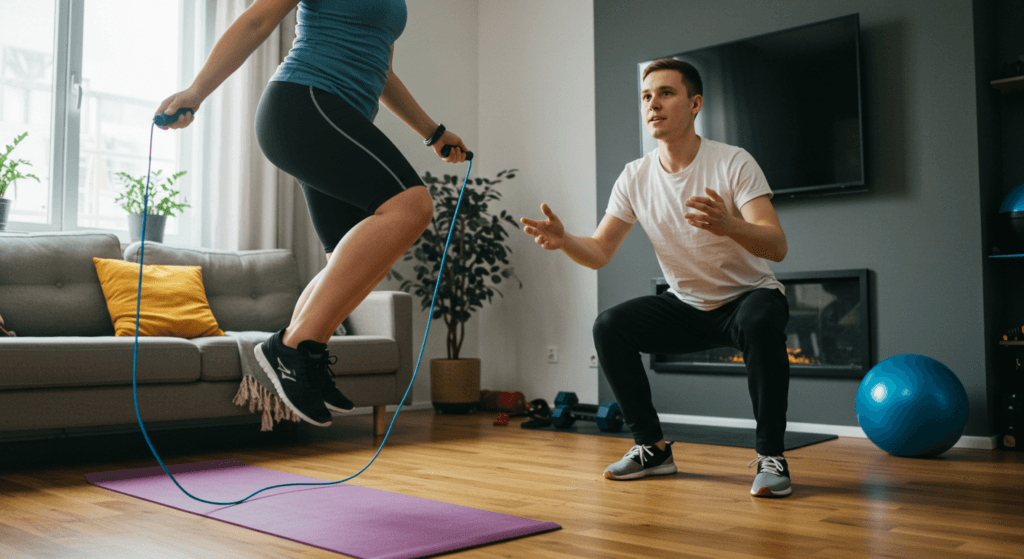
Hard truth: 50% of newbies quit within a month. The solution? Workouts for beginners that skip the frustration—simple moves, doable pacing, and progress that doesn’t require superhuman effort.
By the time you’re done, you’ll know how to set goals that actually stick, skip the usual beginner slip-ups, and stay motivated—no intimidating gym required. Sound good?
Why Workouts for Beginners Need a Solid Plan
Jumping into fitness without a plan? That’s like road-tripping with no GPS—you’ll burn time and gas going nowhere fast. A structured workout plan helps you:
- Track progress
- Prevent injuries
- Stay consistent
Here’s what trainers know: beginners who write down their workout plans see better results. There’s something powerful about putting goals on paper – it transforms vague intentions into clear action steps that keep you accountable.
Fitness Goals That Fit Your Real Life
Start by getting real with yourself: What’s your actual endgame here? Weight loss? Muscle gain? Better endurance? Use the SMART framework:
- Specific: My aim is to shed 10 pounds within the next three months.
- Measurable: Log your workouts and progress every week.
- Achievable: Ease into it with 3 days a week—no need to go all-out with 7 right away.
- Relevant: Align goals with your lifestyle.
- Time-bound: Set a deadline.
Pro Tip: If you’re just starting out, showing up beats going all-out every time. The secret? Consistency that sticks.
How to Create a Workout Plan: A Simple, Step-by-Step Roadmap
Step 1: Select the Best Exercises for Your Goals
Hit compound moves first—they blast multiple muscles at once. Think squats, push-ups, and rows. Boom. These maximize efficiency and build foundational strength.
Sample Beginner Routine (Full-Body):
- Basic Squats: 3 sets of 12 reps
- Push-Ups (knees or wall): 3 sets of 10 reps
- Plank: 3 sets of 20 seconds
Step 2: Balance Cardio and Strength Training
Aim for a 50/50 split between cardio (walking, cycling) and strength training.
| Activity | Duration | Frequency |
|---|---|---|
| Strength Training | 30 minutes | 3x/week |
| Cardio | 20 minutes | 3x/week |
If you’re on a mobile, you might have to swipe left.
Workouts for Beginners at Home (No Equipment Needed)
You don’t need a gym to get started! Here’s a 20-minute home routine:
- Jumping Jacks (3 mins – warm-up)
- Bodyweight Squats (3 sets of 12 reps)
- Push-Ups (3 sets of 8 reps)
- Plank to Down Dog Flow (3 sets of 10 reps)
- Glute Bridges (3 sets of 15 reps)
Benefits of Home Workouts:
- Saves time and money
- Reduces intimidation for beginners
- Builds consistency (the structure of a plan helps you maintain your fitness routine even on days when motivation is low)
The 3-3-3 Approach: A Simple Framework for Beginners
The 3-3-3 Rule is a viral fitness hack for overwhelmed newbies:
- 3 days a week of exercise
- 3 types of workouts: Strength, cardio, flexibility
- 30 minutes per session
Sample Weekly Plan:
| Day | Workout Type | Example Routine |
|---|---|---|
| Monday | Strength | Bodyweight squats, push-ups |
| Wednesday | Cardio | Brisk walking or dancing |
| Friday | Flexibility | Yoga or stretching |
Pro Tip: The 3-3-3 rule turns workouts into daily rituals, not a dreaded grind. Easy, right?
Strength vs. Cardio: Benefits, Results, and When They Fall Short
Why Strength Training Works
Strength training goes far beyond just building bigger muscles. Harvard Health Publishing notes this method kicks your metabolism into higher gear—burning calories even at rest—while also guarding bone density. That’s key, since we naturally lose about 1% of bone mass each year after 40.
- Builds muscle: Boosts your resting metabolism, so you keep torching calories even on rest days.
- Improves bone density: Builds stronger bones, slashing fracture risk (especially crucial after 40).
- Enhances posture: Critical for desk workers.
But It Might Not Work If:
- You skip progressive overload (e.g., not increasing reps/weights).
- Your diet lacks protein (aim for 0.8g per pound of body weight).
Why Cardio Works
Your heart thrives on regular cardio just as much as your body benefits from it. Research shows even simple activities like daily walks deliver powerful health improvements.
- Burns calories: At a relaxed pace, someone weighing 160 lbs can torch about 292 calories in an hour.
- Boosts heart health: Each session pumps up your cardiovascular strength.
- Reduces stress: Triggers natural mood-boosting chemicals for better mental energy.
But It Might Not Work If:
- You overdo it (excessive cardio can increase injury risk and strain joints).
- You neglect strength training (cardio alone won’t build muscle).
Common Mistakes in Workouts for Beginners
Mistake #1: Skipping Warm-Ups
45% of beginners admit to skipping warm-ups, increasing injury risk. Spend 5–10 minutes dynamic stretching or walking.
Mistake #2: Overtraining
“Too much too soon” leads to burnout. Kick off with 3–4 weekly sessions, then slowly ramp it up.
Mistake #3: Ignoring Recovery
40% of injuries happen because beginners skip rest days. Schedule 1–2 rest days weekly.
Key Tip: Mild soreness after workouts is normal, but persistent pain signals a problem. Always prioritize form over intensity.
Essential Exercises for Beginners
Top 5 Beginner-Friendly Moves
- Bodyweight Squats: Builds leg strength.
- Wall Push-Ups: Perfect for building upper body stamina.
- Walking Lunges: Improves balance.
- Plank: Core stability.
- Brisk Walking: Easy cardio, kind to joints.
Staying Motivated
Track Your Progress
Track your sweat sessions – Use apps (MyFitnessPal) or a notebook to log progress. High-five yourself for tiny victories, whether it’s +1 rep or walking 5 extra minutes.
Find a Buddy
Exercising with a friend boosts accountability. Accountability powers through motivation slumps – When willpower fades, knowing others expect you (or that you’ll log it) keeps you moving.
FAQ
Key Takeaways
- Home workouts are effective and budget-friendly.
- The 3-3-3 Rule simplifies fitness for overwhelmed beginners.
- Strength and cardio work best when balanced—neither is a magic bullet.
- Rest days aren’t optional—they’re your secret weapon for gains and staying injury-free.
If you found this article useful, share it with a friend and subscribe to our free newsletter at the bottom of the page so that I can send you more practical exercise tips.


